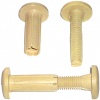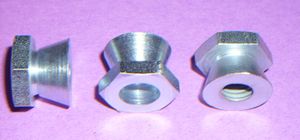Difference between revisions of "Nuts"
(→Dome nut: pic) |
|||
| (8 intermediate revisions by one other user not shown) | |||
| Line 1: | Line 1: | ||
'''Nuts''', adj.: what you must be to attempt this job. | '''Nuts''', adj.: what you must be to attempt this job. | ||
| − | + | ==Nuts used in DIY== | |
| + | [[image:Nut hex 5736-2.jpg|right|100px]] | ||
| + | [[image:Nut square 5737-3.jpg|right|100px]] | ||
| + | [[image:Nut captive 5739-3.jpg|right|100px]] | ||
| + | [[image:Wingnut 5743-2.jpg|right|100px]] | ||
| + | [[image:Nuts nylon lock 5741-2.jpg|right|100px]] | ||
| + | [[image:Sex bolts 5496-2.jpg|right|100px]] | ||
| + | [[image:Nut wi captive serrated washer 5742-2.jpg|right|100px]] | ||
===Hexagon nut=== | ===Hexagon nut=== | ||
| − | |||
The standard nut | The standard nut | ||
===Square nut=== | ===Square nut=== | ||
| − | |||
| − | |||
Most commonly used with roofing bolts | Most commonly used with roofing bolts | ||
===Wing nut=== | ===Wing nut=== | ||
| − | + | For tightening by hand | |
| − | |||
| − | |||
===Nylon lock or nylock nuts=== | ===Nylon lock or nylock nuts=== | ||
| − | |||
| − | |||
The ring of nylon creates friction, preventing the nut coming undone by itself. | The ring of nylon creates friction, preventing the nut coming undone by itself. | ||
| − | |||
| − | |||
| − | |||
===Pronged tee=== | ===Pronged tee=== | ||
| − | [[image:Nutpronged.jpg|thumb|Pronged tee]] | + | [[image:Nutpronged.jpg|thumb|100px|Pronged tee]] |
Has spikes and Fits into a hole in wood. Tightening the bolt pulls the spikes into the wood. | Has spikes and Fits into a hole in wood. Tightening the bolt pulls the spikes into the wood. | ||
| − | |||
| − | |||
| − | |||
===Cross dowel=== | ===Cross dowel=== | ||
| Line 39: | Line 33: | ||
===Flanged nut=== | ===Flanged nut=== | ||
| − | [[image:Nutflange.jpg|thumb|Flanged nut]] | + | [[image:Nutflange.jpg|thumb|100px|Flanged nut]] |
Flange spreads load somewhat like a washer. Ribbing on the flange is intended to discourage the nut from coming loose. | Flange spreads load somewhat like a washer. Ribbing on the flange is intended to discourage the nut from coming loose. | ||
===Dome nut=== | ===Dome nut=== | ||
| − | [[image:Nutdome.jpg|thumb|Dome nut]] | + | [[image:Nutdome.jpg|thumb|100px|Dome nut]] |
Decorative bright polished chrome dome on the topside of the nut. Used where the nut will be in plain view. | Decorative bright polished chrome dome on the topside of the nut. Used where the nut will be in plain view. | ||
| + | |||
| + | ===DIY nut=== | ||
| + | |||
| + | ==More nuts== | ||
| + | There are several other types not usually used in DIY, but available if needed. | ||
===Shear nuts=== | ===Shear nuts=== | ||
| − | The tool driven portion of the nut shears off when tight, leaving a nut that can not be undone with any | + | [[image:Shear nuts 1208-3.jpg|thumb|Security shear nuts]] |
| + | |||
| + | The tool driven portion of the nut shears off when tight, leaving a nut that can not be undone with any type of nut driver. A high security nut. | ||
| + | |||
| + | ===Castellated nut=== | ||
| + | [[image:Nutcastellated.jpg|thumb|100px|Castellated nut]] | ||
| + | |||
| + | Used with a drilled bolt and split pin. Prevents nut coming undone. Used on cars in areas such as wheel bearings. | ||
| − | === | + | ===Rivet bushes=== |
| + | A nut that fixes to a hole in sheet metal. Its riveted in place. | ||
| + | |||
| + | ===Nut insert=== | ||
| + | Presses into a hole in metal. Has a ribbed outer edge. | ||
| + | |||
| + | ===Caged nut=== | ||
| + | A metal cage holds the nut in place next to a square hole in sheet metal. | ||
| + | ===Security nut=== | ||
| + | * Use a dedicated tool to remove | ||
| + | * Less secure than shear nuts | ||
| + | * [http://www.shop4fasteners.co.uk/acatalog/Kinmar_Removable_Two_Way_Security_Nut.asp pic] | ||
==See Also== | ==See Also== | ||
* [[Special:Allpages|Wiki Contents]] | * [[Special:Allpages|Wiki Contents]] | ||
* [[Special:Categories|Wiki Subject Categories]] | * [[Special:Categories|Wiki Subject Categories]] | ||
| − | + | * [[Threaded fasteners FAQ]] | |
[[Category:Fixings]] | [[Category:Fixings]] | ||
Latest revision as of 16:40, 8 June 2020
Nuts, adj.: what you must be to attempt this job.
Nuts used in DIY
Hexagon nut
The standard nut
Square nut
Most commonly used with roofing bolts
Wing nut
For tightening by hand
Nylon lock or nylock nuts
The ring of nylon creates friction, preventing the nut coming undone by itself.
Pronged tee
Has spikes and Fits into a hole in wood. Tightening the bolt pulls the spikes into the wood.
Cross dowel
Interscrews
aka Chicago bolt. A hollow bolt, into which screws a solid bolt. Used to fix kitchen cabinets together.
Flanged nut
Flange spreads load somewhat like a washer. Ribbing on the flange is intended to discourage the nut from coming loose.
Dome nut
Decorative bright polished chrome dome on the topside of the nut. Used where the nut will be in plain view.
DIY nut
More nuts
There are several other types not usually used in DIY, but available if needed.
Shear nuts
The tool driven portion of the nut shears off when tight, leaving a nut that can not be undone with any type of nut driver. A high security nut.
Castellated nut
Used with a drilled bolt and split pin. Prevents nut coming undone. Used on cars in areas such as wheel bearings.
Rivet bushes
A nut that fixes to a hole in sheet metal. Its riveted in place.
Nut insert
Presses into a hole in metal. Has a ribbed outer edge.
Caged nut
A metal cage holds the nut in place next to a square hole in sheet metal.
Security nut
- Use a dedicated tool to remove
- Less secure than shear nuts
- pic








